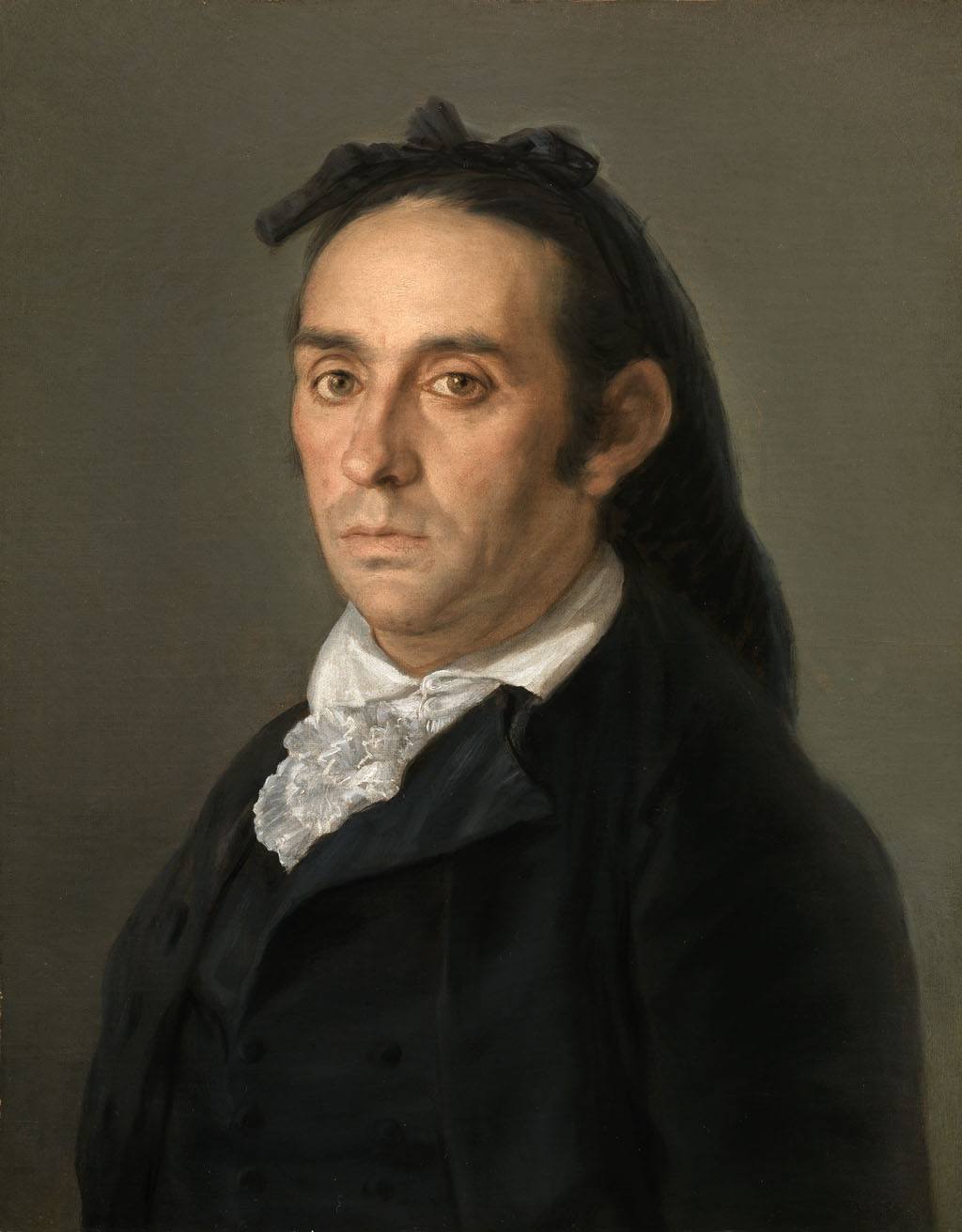27 April 2012
 Francisco De Goya, Portrait Of A Bullfighter (?), C. 1797.
Francisco De Goya, Portrait Of A Bullfighter (?), C. 1797.
Oil On Canvas, 54.4x43.2 cm.
Florence, Galleria Degli Uffizi Contini Bonacossi, Inv. No. 22
The man is depicted in three-quarters view, turning straight to the viewers with a penetrating glance. The background is grey, while the clothes, the hair, and cap are black. The white of the collar, the ruffles, and the light pink of the skin stand out, with slightly more intense parts on the lips, cheeks and nose. The color range is therefore minimal, dominated by subtly modulated cold tones. Scanty in terms of material but nevertheless vibrant, the brushstrokes skillfully design the volumes of the figure, allowing the pink hues of the preparatory stage to emerge in some parts. The rendering of skin already softened by age is truly admirable, as well as the tenuous whitening of the beard on the lower part of the face.
The subject’s long hair is gathered in a delicate black netting that terminates with a rosette above the forehead, leaving uncovered ears, sideburns, and hairline. It is a recurrent costume Goya gives to his bullfighters, as can be seen in the paintings made during his stay at Cádiz (1793), in a number of portraits, or even in the Tauromaquia. This kind of hair netting, albeit in brighter colors, is a typical feature of the male costumes manolos and majos wear in Goya’s genre works. As for the rest of our character’s attire, it is sober and bourgeois, not unlike the clothes worn by Goya’s friend Martín Zapater (Bilbao, Museo de Bellas Artes) in the 1797 portrait. Here the subject has a dark gilet, with a double row of buttons and broad lapel, which he wears over a white shirt with ruffles on the chest. As Longhi had already noticed, Zapater’s effigy is one of the works that comes closest to the Contini portrait, to which it resembles in its original oval shape, in the background color, and in the profundity of psychological excavation.
In view of the exhibition, the painting has undergone a cleaning treatment carried out by Daniele Rossi which has enabled experts to make a more in-depth assessment. The canvas had been stifled by compact layers of yellowing paint that had affected the overall color effect, the finer points of the artist’s painting technique, and the intense rendering of the face.
Camón Aznar has rightly pointed out that the subject in the portrait “appears to be a bullfighter”. While prudently going no further, he does, however, say that the man has that characteristically strong expressivity of majos. Eric Young, in his review of Gudiol’s monograph, has suggested that the unknown subject could well be identified with the famous bullfighter Pedro Romero, whose portrait Goya had made between 1795 and 1798 and which is now kept at the Kimbell Museum of Forth Worth in Texas. Accepted by Rita de Angelis, this identification is based on a degree of resemblance between the two faces, as more clearly emerging in the profile of the eyes, which nevertheless have a different color, and on the fact that the paintings are several years apart. (It should additionally be observed that following a printer’s error de Angelis makes reference to the entry dedicated to José Romero, Pedro’s brother, engendering some confusion in the successive bibliography). But it is the psychology of the two subjects that differs greatly, a difference that cannot really be ascribed exclusively to the older age of the person in the Contini portrait. Pedro is extremely elegant, measured, and self-assured in his posture, with an exquisitely delicate hand hanging down with nonchalance over part of the cloak, and a knowing but serene look. On the other hand, the man depicted in the portrait we are examining is not only older but the skin of his face appears to be heavy (although his hair is less grizzled than Romero’s). His posture, too, is more rigid, while the gaze appears to be lined with a sense of foreboding, and his mouth shut in a fold that shows a touch of sadness and disenchantment.
Signaled by Mayer in 1923 at Mrs. Stern’s of New York, the portrait had previously shown at the Knoedler Gallery in Paris, as can be gathered from the duty stamps of the Parisian customs authorities and the writing –“Knoedler Les 2 tableaux à rendre ce soir”– which can be read on two slips of paper attached on the frame. It was sold to Alessandro Contini Bonacossi prior to 1930 and remained in his collection until it was acquired by the Italian state in 1969. The painting, now cut along the sides, originally had a different shape, presumably oval. The addition of integrative pieces of canvas on the four sides to achieve the current size took place in an unknown date, at the time when the painting was newly lined and framed. This restoration must have necessarily occurred before the painting’s Parisian transit when the above-mentioned slips of paper were attached to the new frame. Mayer has dated the work from between 1795 and 1800, Longhi around 1797 (as a consequence of the affinities with Martín Zapater) while Gudiol believes it was made successively, around 1800.
Taken from Valentina Conticelli’s article in the exhibition catalogue.

Martín Zapater y Clavería, born in Zaragoza on November 12th 1747, came from a family of modest merchants and was taken in to live with a well-to-do aunt, Juana Faguás, and her daughter, Joaquina de Alduy. He studied with Goya in the Escuelas Pías school in Zaragoza from 1752 to 1757 and a friendship arose between them which was to last until the death of Zapater in 1803.
Tuesday - Saturday 10:00 - 19:00
Friday 10:00 - 22:00
Sunday 12:00 - 18:00
The museum is closed on Mondays.
On Wednesdays, the students can
visit the museum free of admission.
Full ticket: 300 TL
Discounted: 150 TL
Groups: 200 TL (minimum 10 people)